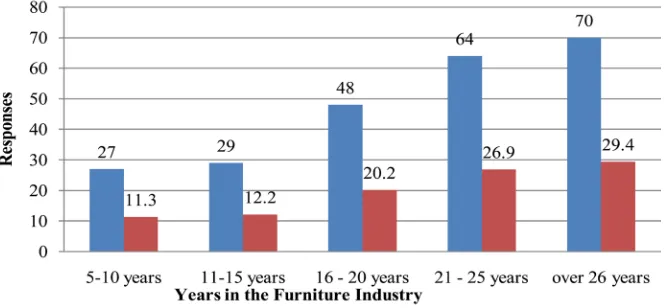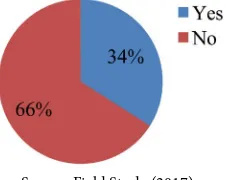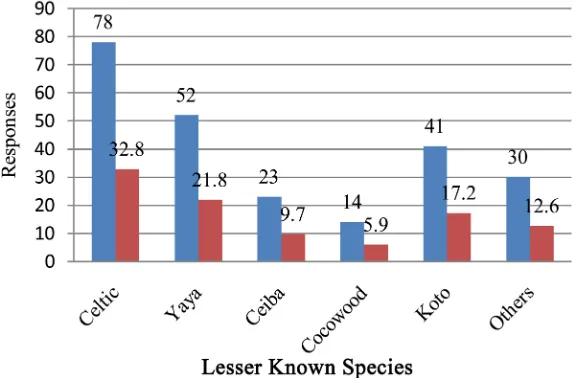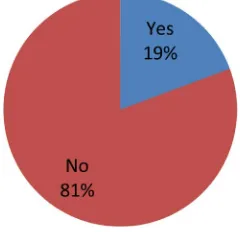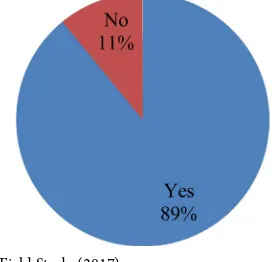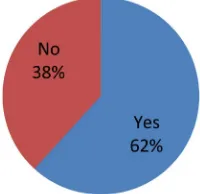ISSN Print: 2333-9705
DOI: 10.4236/oalib.1104916 Nov. 14, 2018 1 Open Access Library Journal
Exploring the Utilization of Lesser-Known
Species for Furniture Production
—A Case Study in the Western Region, Ghana
Job Ewudzie
1, John Gemadzie
1, Harold Adjarko
2*1Department of Interior Design, Faculty of Built and Natural Environment, Takoradi Technical University, Sekondi-Takoradi, Ghana
2Department of Building Technology, Faculty of Built and Natural Environment, Takoradi Technical University,
Sekondi-Takoradi, Ghana
Abstract
Increased demand for traditional timber species has led to the depletion of large areas of Ghana’s forest cover. Sustainable forest management requires that measures are put in place to minimize forest depletion through the uti-lization of lesser-known species, reforestation, setting margins for annual allowable cut, banning export of round logs, conservation of biological di-versity and promotion of efficient wood-based industry. The study aimed at exploring public perception on the use of lesser-known species for making furniture to save our dwindling forest. The research methods adopted were purposive and random sampling. It is purposive because the research was targeted at furniture shops and furniture showrooms and random sampling was used to make the selection. A questionnaire was developed to acquire data for the study from experienced people in the timber industry as well as the general public. Specifically, 450 people were contacted to fill the ques-tionnaire from 15 constituencies out of 29 in the Western Region. Personal interviews were also conducted. The research revealed that most Ghanaians prefer traditional species to the lesser-known ones. Greater part of the pop-ulation prefers species like Odum, Danta, Dahoma, and Denyan etc. For roofing whiles Cedar, mahogany, Makore, Walnut, and Avodirie are used for furniture. The perception is that when the traditional species are used for either roofing or furniture they last longer. Some challenges with the use of lesser-known species are lack of ready market for products may from lesser known species, and lack of requisite machines to work with some of the lesser-known species etc. The study concluded that there is the need here in Ghana to promote the utilization of lesser known species; since
ma-How to cite this paper: Ewudzie, J., Gemadzie, J. and Adjarko, H. (2018) Exploring the Utilization of Lesser-Known Species for Furniture Production—A Case Study in the Western Region, Ghana. Open Access Library Journal, 5: e4916.
https://doi.org/10.4236/oalib.1104916
Received: September 17, 2018 Accepted: November 11, 2018 Published: November 14, 2018
Copyright © 2018 by authors and Open Access Library Inc.
This work is licensed under the Creative Commons Attribution International License (CC BY 4.0).
DOI: 10.4236/oalib.1104916 2 Open Access Library Journal
jority of furniture manufacturers have little knowledge about their usage in the industry.
Subject Areas
Civil Engineering
Keywords
Sustainable Forest Management, Lesser-Known Species, Furniture
1. Introduction
Wood is a critical resource for many rural communities in Ghana, especially in the regions where forest products represent a key industry and a major source of income and employment. The role that the Timber Industry plays in the so-cio-economic development of any country needs not be emphasized. In the 1970s timber was next to cocoa as a major foreign exchange earner in Ghana with a contribution to the Gross National Products of about 11 percent [1]. The highest performance of the industry was recorded in 1973 with log production showing the highest volume of 2.6 million m3. Besides being a source of foreign
exchange earnings, the industry is also a major source of employment in Ghana, currently employing a labour force of over 70,000 [2]. Notwithstanding these benefits the industry faced both operational and structural problems as time went by, to the extent its performance declined, reaching its lowest level in 1982 with a total capacity utilization falling to a meager 15% [2]. According to data on
http://www.ghanatimber.org/ [3], Ghana in May, 2012 considered importing
DOI: 10.4236/oalib.1104916 3 Open Access Library Journal
host of physical, economic and social factors [5]. The study therefore seeks to find out the public perception of lesser-known species used for making furniture and the level of patronage.
2. Previous Research
2.1. Ghana’s Timber Industry and Prospects
Ghana earns most of its foreign exchange by exporting timber, cocoa and gold. When it comes to timber export, the country depends mostly on the forest lo-cated in the Southwest Region. While export earns the country substantial for-eign exchange, from 1990 to 2005, Ghana lost nearly 19 million hectares of forest due to deforestation. According to available statistics the annual rate of defore-station is 2 percent. However, the government has taken some steps to stem the alarming rate of deforestation by coming up with Ghana National Plantation Project which looks to plant 20,000 hectares every year. According to Oku-mi-Andoh, [6] the increased demand for tropical timber used in the housing industry has resulted in depletion of large areas of forest cover. In Ghana be-tween 1900 and 2000, the forest cover over 8 million hectares reduced drastically to 1.4 million hectares. With a rate of deforestation estimated 65,000 hectares per annum. Ghana is likely to lose its forest cover by the year 2022 if deforesta-tion persists [7]. In order to ensure sustainable forest management several coun-tries have put in place measures including utilization of lesser-known species, reforestation, setting margins for annual allowable cut banning export of round logs, conservation of biological diversity and promotion of efficient wood-based industries [8]. There is the general perception that furniture made from less-er-known species is inferior to many Ghanaians. Most of them prefer furniture made with the traditional tropical species such as Cedar, Makore, Avodire, Odum and many more. The increased demand for traditional timber species in depletion of large areas of forest cover has necessitated a study into the alterna-tive use lesser-known species for making furniture to save our dwindling forest.
2.2. Alternatives to High-Grade Hardwood
1) Agricultural Residues
According to Haynes et al. [9], for many reasons in composite board produc-tion, agricultural residues constitute excellent alternative to using virgin wood fibre. Aside their abundance and renewability, using agricultural residues will benefit farmers, industry, human health and the environment. Using agricultural residues for industrial purposes is a much more environmentally friendly prac-tice than other residue disposal methods currently in use, where many farmers dispose of agricultural waste by burning or land-filling.
2) Non-Wood Lingo-Cellulose Biomass
de-DOI: 10.4236/oalib.1104916 4 Open Access Library Journal
fined as wood free of defects such as knots, pith, ingrown bark pockets, small holes, various streaks and stains. Because these defects are part the wood’s natu-ral variability, they are called “character marks”. Furniture made from wood with such characters is called character-marked furniture [10].
3) Low-Grade Hardwood
While low-grade hardwood represents a significant percentage of any sus-tainable harvest, the majority of low-grade logs are now primarily used for pallet stocks, firewood, chips and pulpwood and these uses generate approximately 1 to 2 percent of the revenue from a comparable quantity of high-grade logs. While the total demand for hardwood has been projected to increase 53 percent over the next four decades, most of the projected demand is for high-grade hardwood (Haynes et al. 1995).
2.3. Effect of Increasing Demand for High-Grade Hardwood
The limited inventory of and increasing demand for high-grade hardwood have serious implications for sustainable forest management, the wood products industry and many rural communities that depend on their forest resources. The following are some of the effects:
1) Biological Integrity of Timber
First, economic forces may have influenced harvesting practices in a manner that adversely affects the grade mix and the value of the resource. Driven by short term profits, many landowners may make harvesting decisions with little consideration of the furniture stand quality and these results in the removal of only the largest and best quality trees. Continued removal of higher quality trees has negatively affected the basic conditions for maintaining or improving the bi-ological integrity [11].
2) Competitiveness of Wood Products
Second, increasing timber cost and competition for high-grade timber may increase the demand for wood products and make it more difficult for wood products manufacturers to enhance or maintain their competiveness. Since these problems are primarily due to the lack of suitable markets for low-grade hard-wood, there is a growing interest in probing the potential for using low-grade hardwood to produce high-value products. Adding value to low-grade hardwood through high-value products will directly benefit furniture users and wood products enterprises as well as many rural communities. It may also meet the demand of an increasing number of consumers who want to protect our forest and environment through their purchase of environmentally friendly products
[12] [13].
3. Research Method
DOI: 10.4236/oalib.1104916 5 Open Access Library Journal
if furniture made from lesser-known species is common in many Ghanaian homes. A questionnaire was also developed to acquire data for the study from experienced people in the timber industry. The researchers visited 15 consti-tuencies out of 29 in the Western Region. In each constituency 30 people were interviewed from some selected wood workshops and furniture showrooms. Personal interviews were also conducted. Specifically, 450 people were contacted to fill the questionnaire. The sample size gave a fair representation of people’s opinion about furniture made from lesser-known species.
4. Results and Discussion
Length of Years in the Furniture Industry
Seventy people responded that their companies have been in existence for more than 26 years and over (See Figure 1). Sixty-four had been between 21 - 25 years in the furniture industry and just twenty-seven had been in the furniture industry between five to ten years. This shows that most of the respondents have been in the wood industry for quite a long time and therefore could share their experience in the industry (Personal communication with managers in the tim-ber industry).
The results in Figure 2 show that 25% (59) out of 238 (75%) who responded to the questions said they have knowledge about lesser-known species.
[image:5.595.209.541.387.541.2]Source: Field Study (2017).
Figure 1. Length of years in the furniture industry.
Source: Field Study (2017).
[image:5.595.297.452.586.704.2]DOI: 10.4236/oalib.1104916 6 Open Access Library Journal
[image:6.595.318.431.608.698.2]Majority of them 179 (75%) said they do not have any knowledge about less-er-known species. They only knew about the traditional species such as Odum, Wawa, Makore, Dahoma and many others. According to the Ministry of Lands and Forestry [7], in order to ensure sustainable forest management, several countries have put measures including utilization of lesser-known species, re-forestation, setting margins for annual allowable cut, banning export of round logs, conservation of biological diversity, and promotion of efficient wood-based industries. The study has revealed that there is the need here in Ghana to pro-mote the utilization of lesser known species; since majority of furniture manu-facturers have little knowledge about their usage in the industry.
Figure 3 shows that 81 (34%) of the people have used lesser-known species to make furniture before. The rest 154 (66%) of the people have not use some be-fore. Whiles the government is encouraging people to use lesser-known species as a substitute to high grade lumber in many countries, majority of Ghanaians are not utilizing them. Vlosky [13] stated that, adding value to low-grade hard-wood through a high-value product will directly benefit furniture users and wood products enterprise as well as many rural communities. It may also meet the demand of an increasing number of consumers who wants to protect our forest and environment through their purchase of environmentally friendly products.
The results indicated that, the mostly used lesser-known specie is celtic. Out of the 238 who responded to the questions, 78 (32%) said they mostly use celtic. Fifty-two (21.8%) also said they use yaya. Forty-one (17.2%) of them also indi-cated that they use koto. Others such as Chenchen, Esa and many more came with 30 (12.6%) whiles ceiba and cocowood followed with 23 (9.7%) and 14 (5.9) respectively (Figure 4).
As to where furniture makers obtain lesser-known species to purchase, the results show that most of them get some to buy from the timber market whiles few places special order from sawmills or chainsaw operators. The bar chart above shows 170 respondents representing (71.4%) recording the highest per-centage of those who buy lesser-known species from the timber market and 68 respondents representing (28.6%) also said they place special order from saw-mills and chainsaw operators (Figure 5).
The researchers also sought to find out from the respondents if lesser-known species are available all the time in the local market. The results show that 77%
DOI: 10.4236/oalib.1104916 7 Open Access Library Journal
[image:7.595.230.519.71.260.2]Source: Field Study (2017).
Figure 4. Mostly used lesser-known species.
[image:7.595.213.533.303.441.2]Source: Field Study (2017).
Figure 5. Source of lesser-known species for furniture production.
of the respondents said that lesser-known species are not always available in the local market. Vlosky [13] stated that due to lack of suitable market for low-grade hardwood, there is growing interest in probing the potential for using low grade hardwood to produce high-value products. Adding value to low-grade hardwood through high-value products will directly benefit furniture users and wood products enterprises as well as many rural communities. It may also meet the demand of an increasing number of consumers who want to protect the forest and environment through the purchase of environmentally friendly products (Figure 6).
Majority of the respondents who answered the question on whether people buy furniture made with lesser-known species 175 respondents making 74% said no whiles 63 respondents making 26% also said yes (Figure 7).
DOI: 10.4236/oalib.1104916 8 Open Access Library Journal
to order furniture made with lesser known species from their shops. Vlosky [13]
said that increasing timber costs and competition for high-grade timbers may increase the cost of wood products and may make it more difficult for wood products manufacturers to enhance or maintain their competitiveness. These problems are primarily due to the lack of suitable markets for low-grade hard-wood to produce high value products. The research revealed that most Gha-naians prefer traditional species to the lesser-known ones. Out of 238 respon-dents who answered what is the perception of people about furniture made with lesser-known species to that of traditional species. Two hundred and thirty-one of them said they prefer using the traditional species. Seven of the respondents said they prefer the lesser-known to the traditional species. Those who said they prefer traditional species gave reasons that the lesser-known ones are difficult to purchase in the local timber market (Figure 8).
[image:8.595.330.414.279.361.2]Source: Field Study (2017).
Figure 6. Availability of lesser-known species on local market.
[image:8.595.311.434.413.532.2]Source: Field Study (2017).
Figure 7. Customers patronage of furniture made from lesser-known species.
Source: Field Study (2017).
[image:8.595.313.433.577.694.2]DOI: 10.4236/oalib.1104916 9 Open Access Library Journal
As to how wood processers compare the usage of both the traditional species and the lesser-known species, 89% of respondents preferred working with the traditional species to working with the lesser-known species, reason being that tools and machines for working on them are always available. Also, the results on the perception about furniture made with lesser-known species to that of the traditional species such as Odum, mahogany, Cedar, Avodrie, Walnut, and many more indicated that majority of the respondents, 89%, said they prefer traditional species to that of lesser-known species. Again, it was revealed that in Ghana, greater part of the population prefer species like Odum, Danta, Dahoma, Denyan etc. for roofing whiles Cedar, mahogany, Makore, Walnut, and Avodirie are used for furniture. The perception is that when the traditional species are used for either roofing or furniture they last longer (Figure 9).
The researchers sought to find out when companies started using less-er-known species to produce furniture. The results revealed that out of 238 res-pondents, 57 of them (23.9%) said they have used lesser-known specie between the past 5 to10 years. Forty-three of the respondents making (22.3%) also indi-cated that they have used it between the past 11 to 15 years whiles 39 of them (16.4%) have also used it between the past 16 to 20 years. Twenty-two of the respondents said they have used it between the past 21 to 25 years and 67 of them also said they have used it for more than 26 years (Figure 10).
[image:9.595.302.440.386.517.2]Source: Field Study (2017).
Figure 9. Usage of furniture based on type of timber.
Source: Field Study (2017).
[image:9.595.213.541.551.694.2]DOI: 10.4236/oalib.1104916 10 Open Access Library Journal
As to whether companies find it difficult to process lesser-known species, 62% of the respondents said they find it difficult to process while 38% also said they do not find it difficult to do so (Figure 11).
The research revealed that most companies prefer working with the tradition-al species to the lesser-known species. Out of the 237 respondents 234 of them said yes, they prefer working with the traditional species while 3 respondents said no they like working with the lesser-known species. According to the min-istry of lands and forestry [7] in order to ensure sustainable forest management, several countries have put in place measures including utilization of less-er-known species, reforestation, setting marginal for annual allowable cut, ban-ning of export of round logs, conservation of biological diversity and promotion of efficient wood-base industry. And from the researcher’s personal interview with some employers and employees, it was observed that most the most com-panies do not have the requisite machines to work with some of the less-er-known species (Figure 12).
The results in Figure 13 show that most Ghanaians use furniture base on the
[image:10.595.323.423.324.421.2]Source: Field Study (2017).
Figure 11. Ease of processing of lesser-known species.
[image:10.595.317.426.466.574.2]Source: Field Study (2017).
Figure 12. Ease of finishing of lesser-known species.
Source: Field Study (2017).
DOI: 10.4236/oalib.1104916 11 Open Access Library Journal
type of species. Eighty three percent of the respondents said the lesser-known species are not as durable as the traditional species whiles (17%) said that less-er-known species are durable. Okumi-Andoh [6] revealed that the increasing demand for tropical timber use in the housing industry has resulted in the dep-letion of large areas of forest cover. Okai [7] attests to that fact that Ghana is likely to lose her forest cover by the year 2022 if deforestation persists at the current rate.
5. Discussions
Although Ghana is generally considered as a country with abundant forest in-ventories, the available high-grade hardwood is quite limited due to a host of physical, economic and social factors. While the demand for wood products has been projected to grow a significant rate, a major problem faced by the wood products industry is a shortage of high-grade hardwood and contributed to the increasing pressure on the forest and the environment [6]. Analysis from the re-sults revealed that most people do not have knowledge on the use of less-er-known species. Research has shown that in the 1970s timber was next to co-coa as a major foreign exchange earner in Ghana with a contribution to the Gross National Products of about 11% and started to decline reaching its lowest level in 1982 with a total capacity utilization fallen to a meager 15 percent [2]. Ozame and Smith [12] noted that increasing timber cost and competition for high-grade timber may increase the wood products and make it more difficult for wood products manufacturers to enhance or maintain their competitiveness. Since these problems are primarily due to the lack of suitable markets for low-grade hardwood, there is a growing interest in probing the potential for us-ing low-grade hardwood to produce high value products. Addus-ing value to low grade hardwood through high value products will directly benefit furniture users and wood products enterprises as well as many rural communities. The results revealed that many woodworkers do not have knowledge about the use of less-er-known species for making furniture. Out of 238 respondents 75% of them said they have no knowledge about making furniture with lesser-known species whiles 25% of them said they have knowledge about using lesser-known species to make furniture. Again, it was obvious from the results that few woodworkers use lesser-known species to make furniture. The rest do not use. Thirty-four percent of the respondents said they have use lesser-known species to make fur-niture before. Whiles the government is encouraging people to use lesser-known species as substitutes to high-grade lumber, majority of the people are not using them. The results also shown that, most lesser-known species are not always available in local market. Celtic, Yaya and Koto were the lesser-known species that could be found in the local timber markets.
DOI: 10.4236/oalib.1104916 12 Open Access Library Journal
them said they have used some before. Furthermore, the researchers got to know that most people do not go to order furniture pieces from the workshops; rather they buy already made ones from outside. It was clear from the results that, 81% of the respondents said people do not come to order lesser-known furniture from them but 19% said people come to order lesser-known furniture from their workshops. The research revealed that, most Ghanaians prefer traditional spe-cies to lesser-known ones. As to how wood processers compare the usage of both the traditional species and the lesser-known species 89% of them said they prefer working with traditional species to lesser-known species. Their reason was that tools and machines to work with the traditional species are always available, whiles that of traditional species are difficult to get.
6. Conclusion
The purpose of the study was to find out if furniture made with lesser-known species is common in many Ghanaian homes. The researchers sought to find out innovative ways of using lesser-known species to produce high-value products to save the degrading forest. The study revealed that many people do not have knowledge about the use of lesser-known species for furniture. It showed that people use furniture based on the type of species which are predominantly tradi-tional species such as Odum, Wawa, Mahogany, Makore, Danta, Dahoma and many more which have been in existence since time immemorial [14]. This was the reason why most companies prefer using the traditional species for furniture making. Again, it showed that lesser-known species are not common in the local timber markets. The few common ones sometimes available in the local timber markets are Celtic, Yaya and Ceiba. The rest such as, Koto, Cocowood, Chen-chen, Esa and others are ordered before they can be obtained. In addition, ma-chines to process some lesser-known species are not common in the local timber markets. Few of the companies have machines for processing lesser-known spe-cies. The tools and machines for processing traditional species are available in the local timber markets and the woodwork shops. Furthermore, the results showed that when one compares the number of years’ people who started using lesser-known species and the traditional species it was clear that many people do not know lesser-known species and that may be the reason why people do not patronize furniture made with lesser-known species.
7. Recommendations
The recommendations were based on the findings and conclusion drawn from the study by the researchers. It is therefore recommended that;
• People should patronize products made with lesser-known species as an
al-ternative to the traditional species to save the forest.
• People should be sensitized so that products made with lesser-known species
will not be seen as inferior.
DOI: 10.4236/oalib.1104916 13 Open Access Library Journal
therefore these tools should be made available for the processing.
• The depletion rate of the country’s forest requires that alternative materials
be used for furniture production.
Acknowledgements
The authors wish to acknowledge the immense support of Dr. Okumi Andoh and Mr. Kwame Ofosu Larbi of the Faculty of Built and Natural Environment, Takoradi Technical University; also, to Mr. Frank Gyasi and Enoch Tutu for their help in administration of the questionnaires.
Conflicts of Interest
The authors declare no conflicts of interest regarding the publication of this pa-per.
References
[1] International Institute for Environment and Development (1996) Towards a Sus-tainable Paper Cycle. Bazette and Associates, Victoria, BC.
[2] Forest Products Inspection Bureau and Ministry of Lands and Forestry (1994) Ex-port Permit ReEx-ports 1992-1996. Takoradi.
[3] (2012). http://www.ghanatimber.org/
[4] Lin, W., Kline, D.E. and Araman, P.A. (1994) Dimension Yields from Factory Grade 2 and 3 Red Oak Logs. Forest Products Journal, 44, 19-25.
[5] Araman, P. and Tansey, J. (1991) U.S. Has Plenty of Hardwood but Much of It Is Not for Sale. Forest Industries, 118, 16-17.
[6] Okumi-Andoh, E. (2013) Utilization of Corn Stork and Sugarcane Badasse for the Production of Particle Board. Journal of Technology, 1, 1-9
[7] Okai, R. (2001) Sawing Characteristics and Mechanical Strength Properties of Branch Wood of Some Ghanaian Timber Species from Sustainably Managed Fo-rests. ITTO Project Ref. 064/98A.
[8] Ministry of Lands and Forestry (1996) Circular on Air-Dry Levy. Accra.
[9] Haynes, R.W., Adams, D.M. and Mills, J.R. (1995) The 1993 RPA Timber Assess-ment Update. General Technical Report RM-259, US DepartAssess-ment of Agriculture, Forest Service, Rocky Mountain Forest and Range Experiment Station, Fort Collins, 66 p.https://doi.org/10.2737/RM-GTR-259
[10] Buehlmann, U., et al. (1998) Character Marked Furniture: Potential for Lumber Yield Increase in Rip-First Rough Mills. Forest Products Journal, 49, 65-72. [11] Noss, R.F. (1993) The Wildlands Project: Land Conservation Strategy. Wild Earth,
10-25.
[12] Ozame, I.K. and Smith, P.M. (1996) Consumer Segments for Environmentally Marketed Wooden Household Furniture. Wood and Fiber Science,28, 459-479. [13] Vlosky, R. andOzanne, L.K. (1997) Willingness to Pay for Environmentally
